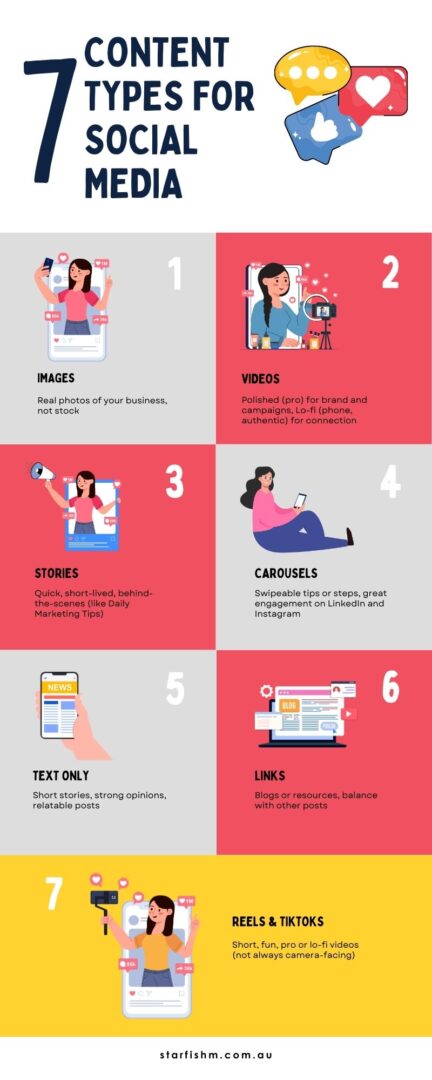How to make your social media more effective
Social media often gets bundled into one big “content” bucket, but not all content works the same way.
Some content is great for sparking conversations, some is better for teaching, and some is just there to keep you visible. Knowing the difference — and choosing the right mix — makes a big difference to how effective your socials are.
If you’ve been following along with this series, we’ve already looked at building brand presence, organic vs paid social media, and social media engagement tips. This time, we’re focusing on content types and the best practices that make them work.
No-one wants to spend time creating content that gets zero engagement and vanishes into the feed. Understanding content types and best practices for social media is what stops that from happening.
Different content types and why they matter

Here’s the fun part: you don’t have to do everything. But understanding the different content types and best practices for social media helps you choose the right ones for your business.
Images
The bread and butter of most social feeds. They’re easy, visual, and quick for your audience to consume. But lazy stock photos? They won’t cut it. People want real photos of your business, your people, your world.
It’s worth investing in a proper image library with a professional photographer to achieve this.
Having a bank of on-brand photos ready to go makes creating content a whole lot easier. It means you can plan content strategically and know you’ve always got strong visuals that reflect your business.
Professional shots instantly lift the quality of your socials, and they make your planning process smoother.
If you’re not sure where to start, I can recommend photographers and even project manage the shoot so you end up with a library of images that actually work for your marketing.
Videos
There are two main types: polished and lo-fi.
Polished videos are where you bring in the professionals.
Think brand videos, testimonials, or campaign-style content. They look sharp, sound great, and show your business at its best.
The benefit? They’re perfect for setting the tone of your brand and for content you can use across multiple platforms.
Lo-fi videos are at the other end. Lo-fi literally means “low fidelity”, content that isn’t heavily produced.
It might be you filming on your phone, a quick walkthrough of your workspace, or a client Q&A recorded in the moment.
Lo-fi works because it feels more authentic and immediate. Your audience sees the “real you,” and that can often create stronger connection than something polished.
Both styles have their place, and having a plan for when to use each keeps your content balanced.
Stories
Stories are short-lived, but that’s what makes them powerful. They’re designed for quick, in-the-moment content, things that don’t need to live on your feed forever.
For example, my Daily Marketing Tips go out on stories. They’re quick, digestible reminders that people can flick through each day.
On the other hand, my Instagram feed is where you’ll see more evergreen content, educational posts that you can come back to any time. Both work, but they do different jobs.
Carousels
Carousels let people swipe through multiple slides in a single post.
They’re perfect for breaking down tips or steps without overwhelming people in one chunk of text.
Right now, they’re performing really well on LinkedIn, and they’re also getting strong engagement on Instagram. Because carousels encourage swiping, saving, and sharing, they’re a great tool to build engagement and worth factoring into your content plan regularly.
Text-only posts
These can still pack a punch, especially if you’ve got something to say.
A strong opinion, a short story, or a relatable observation written out as text can cut through the noise. Sometimes, stripping away the visuals makes the message stand out even more.
The trick is knowing when to use them as part of your broader mix.
Links
Useful for sharing blogs or resources, but don’t expect them to fly.
Platforms like Facebook and LinkedIn want people to stay on their site, so link posts don’t always get as much reach.
That doesn’t mean you shouldn’t share them. Just build them into your plan strategically alongside content that keeps engagement high.
Reels and TikToks
Short, punchy videos. No, you don’t need to point at text bubbles or dance (unless you really want to). You can film your product in use, capture an event, record a timelapse of your process, or use text overlays on top of footage.
These can be a mix of professional (with great lighting, editing, captions) and lo-fi (shot on your phone, in the moment). Both styles can work, and knowing when to use which makes them more effective.
At the end of the day, the trick isn’t doing all of these content types. It’s important to test and measure. Try a few different types, look at your insights, and pick the mix that suits your ideal clients and your time.
Best practices that actually work
It’s one thing to know what types of content exist. It’s another to apply the right content types and best practices for social media so your efforts actually deliver results.
Here are some best practices I’ve seen work across businesses (and yes, that includes my clients here in Albury Wodonga).
Quality over quantity
Posting just to tick the box is one of the fastest ways to lose people’s attention. You don’t need to post every day.
In fact, posting less but making it count is more likely to get you better results. One thoughtful, useful post a week is worth more than five filler graphics that say nothing.
Think about what your ideal clients will get from your content before you hit publish.
Be strategic
Every post should have a purpose. Are you:
- trying to educate?
- start a conversation?
- show personality?
If the answer is “I don’t know, I just needed something to post,” then stop.
Knowing that your posts have a purpose is where a content plan helps. It keeps you focused on the why behind each post instead of throwing spaghetti at the wall (and hoping something sticks).
Stay consistent
Consistency doesn’t mean posting three times a day. It means showing up regularly enough that people remember you. Once a week, once a fortnight, whatever rhythm you can realistically stick with. The key is that your ideal clients know you’ll keep showing up.
Remember, it’s better to share one valuable post on a consistent schedule than flood your feed with half-baked content.
People would rather see less from you if it’s worth their time, instead of constant noise that adds nothing. Ignore anyone who tells you your business will collapse if you don’t post daily. I’ve tested it, and it’s rubbish.
Add value first
This is the golden rule. If your content doesn’t help, teach, or entertain your audience, why would they engage with it?
Value doesn’t always mean giving away free advice either. It could be sparking a thought, making someone smile, or giving them a little “ah-ha” moment.
Put your ideal clients first. Consider what drives their decision making and what are their pain points. Create content that focuses on that and the value will follow.
Mix it up
No one wants to scroll through the same type of post over and over again.
If all you ever share is text graphics, people will switch off. A mix of images, videos, stories, carousels, and text-only posts keeps your feed fresh and gives different people different ways to connect with you.
The important part is to be strategic about it.
Choose content types that support your goals and speak to your ideal clients, not just whatever’s easiest to post on the day.
Check your insights regularly. They’ll tell you what your clients are actually engaging with and what they value. Variety for the sake of variety won’t get results, but variety that’s planned, purposeful, and informed by data will.
Keep it human
This is one I will always come back to.
Social media isn’t about being perfect. It’s about connection. Show your human side, share real stories, and stop worrying about everything being polished.
And no, I don’t mean oversharing your private life. Just let people see that you’re human.
A polished video has its place, but so does the slightly messy video that makes people feel like they’re in the room with you.
And while we’re here, please, stop reposting generic “inspirational quotes” without context. Unless it’s genuinely something you believe in, and you add your own take, it just blends in with the thousands of other posts out there. Save yourself the Canva template and share something original.
Common mistakes to avoid
I’ve seen a lot of businesses struggle because they ignore the basics of content types and best practices for social media and end up wasting time on the wrong things. So here’s a few common mistakes to avoid.
Only posting one type of content (hello, wall of graphics)
Relying on a single format, whether it’s endless graphics, constant text posts, or only videos, limits how many people you reach.
Different people prefer different ways of consuming content. By sticking to one format, you risk talking to just a fraction of your ideal clients.
A better approach is to plan a content mix that plays to your strengths and gives your ideal clients options for how they engage with you.
Using jargon your audience doesn’t understand.
We’re all guilty of it sometimes, but technical terms or industry-speak can lose people instantly.
If your audience has to Google what you mean, they’re not going to stick around. Keep it simple, clear, and in everyday language
Forgetting to check insights (you need to know what’s working)
Posting without ever looking at what’s working is like cooking without tasting.
Insights show you what your audience actually values, which content they save, share, or comment on.
Ignoring that data means you’re guessing instead of making informed, strategic decisions.
Copying competitors (instead of finding your own voice)
Watching what others do is fine, and can be great for inspiration, but copying them won’t build your brand.
Your voice, your personality, and your way of helping clients are what set you apart. If you’re just replicating someone else’s style, you’ll blend into the background.
Thinking you have to use every feature or trend (You don’t)
You don’t need to jump on every TikTok audio, every Instagram trend, or every new feature that launches. More on that here.
Trends can be fun, but they should only be part of your content plan if they make sense for your business and audience.
Expecting instant results
One post, or even one campaign, isn’t going to change your business overnight.
Organic content takes time, and even paid needs consistency to work properly. Expecting quick wins usually leads to disappointment.
The businesses that see results are the ones that show up consistently and keep at it.
Why content variety builds effectiveness
Different people engage in different ways.
Some love video. Others prefer a quick graphic. Some will click through to read a blog, others will only ever swipe a carousel.
By offering a mix, you’re giving your ideal clients more ways to connect with you and more chances to build that know, like, trust factor I’ve been banging on about for years.
Making your content work harder
At the end of the day, content types and best practices aren’t about ticking boxes. They’re about making social media work for your business.
Choose a few content types that make sense for you, apply the best practices that feel achievable, and keep showing up.
And remember that you don’t need to do everything. You just need to do the right things, consistently, for your ideal clients.
Ready to simplify your social media?
If you’re tired of feeling like social media is taking up too much time (without delivering much back), that’s where I can help.
I work with businesses to create organic social content that builds presence, engagement, and trust, so your marketing actually happens and makes sense for your business. If this is something you need help with, let's talk.
Common questions about content types and best practices
What content types work best on social media?
It depends on your audience, but a mix of images, videos, stories, carousels, and text posts usually works well.
How often should I post different content types?
Consistency matters more than frequency. Choose a rhythm that works for you and focus on sharing valuable content regularly.
Do I need to use every content type to be effective?
No. Pick the content types that suit your business, your audience, and your time. Quality and value matter more than using every feature.
If you need help with your organic social media, let's talk.



